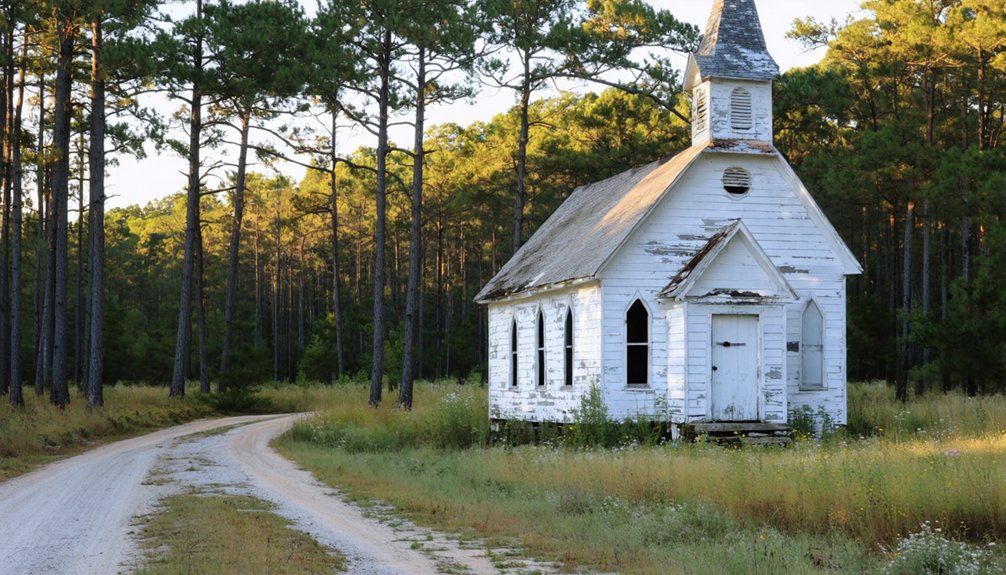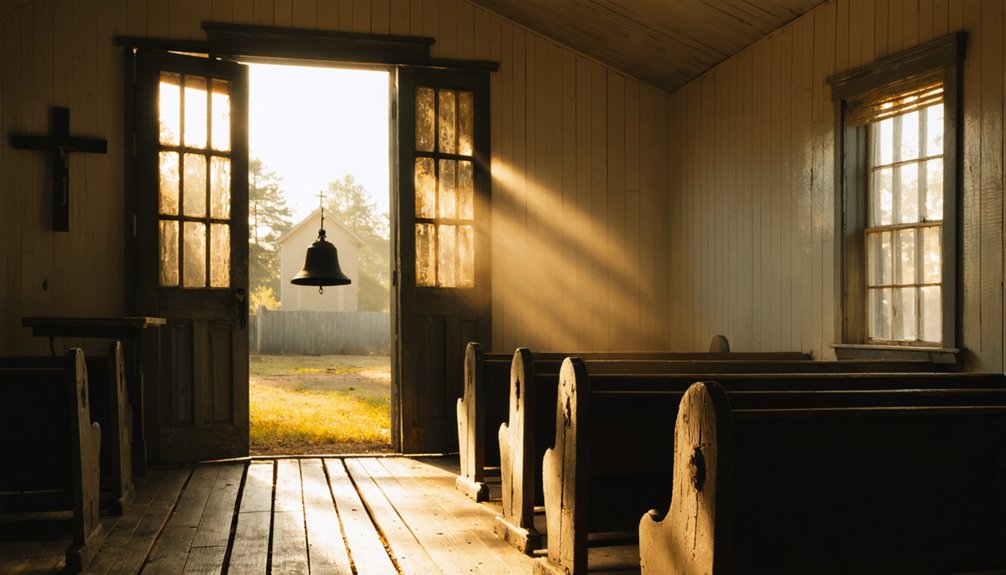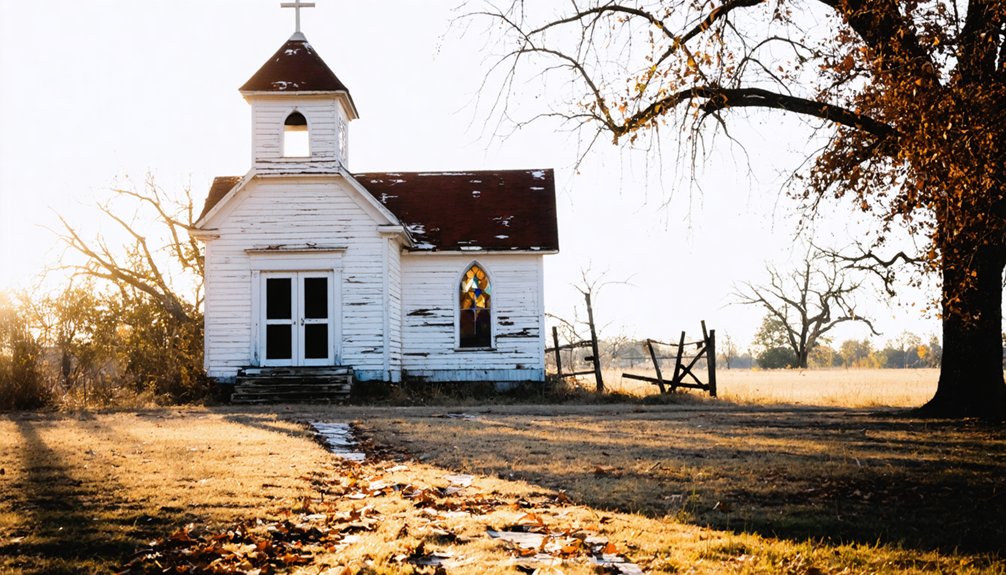You’ll find Henry’s Chapel nestled at the crossroads of FM 13 and 856 in Cherokee County, Texas, about 23 miles northeast of Rusk. Founded in the 1820s and named after Reverend William Porter Henry, this historic ghost town maintains a stable population of around 75 residents. While its Presbyterian church, school, and stores have closed, the community’s spirit lives on through its historic cemetery and strong cultural heritage. The town’s fascinating journey from frontier settlement to resilient rural community reveals a deeper story of faith and determination.
Key Takeaways
- Henry’s Chapel is an unincorporated community in Cherokee County with around 75 residents, classified between a historic settlement and ghost town.
- The settlement declined after being bypassed by railway in 1872, leading to closure of local stores, churches, and school consolidation.
- Named after Reverend William Porter Henry, who donated land in 1874 for a school, church, and cemetery.
- The historic cemetery remains active and maintained, serving as a cultural anchor and testament to the community’s past.
- Located at Farm to Market Roads 13 and 856 intersection, 23 miles northeast of Rusk and 6 miles southeast of Troup.
Early Settlement and Naming Origins
While pioneers from Arkansas sought new opportunities in Texas during the early 1820s, they established what would become Henry’s Chapel in northeastern Cherokee County. Following typical East Texas settlement patterns, this rural community grew slowly around farming and local trade activities.
You’ll find the area’s naming significance tied to Reverend William Porter Henry, a Cumberland Presbyterian minister who arrived in 1848. When he donated five acres of land in 1874 for a school, church, and cemetery, the community officially became known as Henry’s Chapel.
Before this, the area had connections to nearby Knoxville, which was platted in 1854. Much like how safe river crossings determined early Texas settlement locations, the name reflects both the strong religious influence and local leadership that characterized many frontier settlements during Texas’s mid-19th century development. The town prospered until the railway bypass in 1872 caused many residents to relocate to Troup.
Religious Foundations and Community Development
Reverend William Porter Henry’s 1874 land donation marked a defining moment in Henry’s Chapel’s religious foundation, establishing the core institutions that would shape community life for generations.
Through his Presbyterian ministry and community-building efforts, he fostered spiritual leadership that kept the settlement thriving even after nearby Knoxville’s decline.
You’ll find that religious life centered on both Presbyterian and Methodist traditions, with Methodist circuit rider Joe Wells leading the first formal Methodist congregation. Like itinerant preacher Stevenson, ministers traveled through the region to serve scattered congregations.
The five-acre donation from Rev. Henry created a sacred space where a historic cemetery now stands as the last physical reminder of this once-vibrant community.
The five-acre donation hosted Sharp Top School and a church, creating a hub for community cohesion through education and worship.
The churches adapted to serve multiple roles – hosting social gatherings, civic events, and religious education through women’s missionary societies and youth groups.
These institutions proved essential in sustaining the community through economic and demographic changes.
Geographic Location and Population

Nestled in northeastern Cherokee County at the crossroads of Farm to Market Roads 13 and 856, Henry’s Chapel sits approximately 23 miles northeast of Rusk and 6 miles southeast of Troup, Texas.
You’ll find this unincorporated community at roughly 32.10667°N latitude and 95.04250°W longitude, within the Tyler-Jacksonville combined statistical area.
The geographic features of Henry’s Chapel reflect its rural character, with open farmland and scattered residential plots defining the landscape. Similar to the town of Shafter, the area features a historic cemetery that serves as a testament to its past.
While many similar communities have vanished entirely, Henry’s Chapel has shown remarkable population stability, maintaining around 75 residents from the mid-1930s through 2000.
Though it’s now considered a ghost town, the area’s cultural significance lives on through its historic cemetery and the remaining dispersed rural community. According to Chicago Manual Style guidelines, the town’s history was first documented in 1934.
Historical Infrastructure and Services
Since its founding in 1848 around Presbyterian minister William Porter Henry, Henry’s Chapel developed essential infrastructure that served its rural community for nearly a century.
You’ll find the town’s early development centered around Henry’s land donations in 1874, which established both the Presbyterian church and Sharp Top School. At its peak, you could visit two local stores and send your children to the school, which served 27 students by 1897. Today, only one cinderblock church building remains standing from the original three churches that once served the community. Like the town of Alton in Denton, only a cemetery and a few ruins remain as visible reminders of the past.
However, infrastructure decline began when the railway bypassed the area in 1872, favoring nearby Troup. By the 1930s, you’d see the beginning of the end as community services dwindled. The school consolidated with Carlisle ISD, the stores closed, and the Presbyterian church shuttered, though the historic cemetery remains as a symbol to the town’s past.
Educational Legacy Through Time
You’ll find the educational roots of Henry’s Chapel in the 1874 donation of five acres by Reverend William Porter Henry, which established the Sharp Top School serving around 27 students by 1897.
The school operated continuously until the 1930s when state-wide consolidation efforts and improved transportation networks led to its closure, reflecting broader changes occurring across rural Texas communities. Like many other schools during this era, it followed the path of Knoxville’s old school, which had shuttered as businesses and residents relocated.
Unlike the isolated community depicted in Graham Guest’s novel where children received no formal education, today’s students attend the Carlisle Independent School District, marking the community’s shift from an intimate local schoolhouse to integration within modern regional education systems.
Early Schoolhouse Growth
The educational legacy of Henry’s Chapel began in 1874 when Presbyterian minister William Porter Henry donated five acres of land for a school, church, and cemetery.
This generous donation led to the establishment of Sharp Top School, known for its distinctive steep-pitched roof.
The school infrastructure served as both an educational center and community hub, reflecting the close-knit nature of rural life.
Modern District Integration
As Sharp Top School evolved through the late 1800s, Henry’s Chapel‘s educational landscape witnessed significant changes that shaped its modern identity.
You’ll find that by 1897, the school’s enrollment of 27 students demonstrated the community’s dedication to education despite rural challenges.
The 1930s marked a turning point when Henry’s Chapel’s school consolidated with Graham schools, reflecting Texas’s broader shift toward centralized modern education.
Today, you’ll see the area served by Carlisle Independent School District, a transformation that speaks to changing times and needs.
While the original school buildings no longer function as educational centers, their legacy lives on through the community’s integration into a contemporary district framework, adapting to meet the demands of modern rural education while preserving its historical roots.
Current Status and Classification
While many ghost towns in Texas lie completely abandoned, Henry’s Chapel maintains its classification as a “dispersed rural community” according to the Handbook of Texas.
You’ll find this site falls somewhere between a historic settlement and a ghost town, with current habitation patterns showing only scattered residents across its rural expanse.
Unlike completely deserted towns, Henry’s Chapel exhibits a semiabandoned status, with a few remaining structures still standing but minimal population presence.
You won’t find the bustling tourism or preservation efforts that characterize better-known ghost towns like Terlingua.
The site’s sparse population and lack of organized community activities reflect the broader trend of rural depopulation in Texas, though it hasn’t reached the point of total abandonment.
Community Life and Cultural Heritage

If you’re exploring Henry’s Chapel, you’ll find a community whose identity remains deeply rooted in its Presbyterian heritage, established by William Porter Henry’s spiritual leadership and five-acre land donation in 1874.
The church and cemetery he established continue to serve as physical anchors of local cultural life, preserving the community’s religious foundations despite broader regional changes.
Though many rural Texas communities have vanished entirely, Henry’s Chapel maintains its distinct character through shared religious traditions and a scattered but connected population of farmers and craftsmen.
Religious Roots Run Deep
Deep religious foundations shaped Henry’s Chapel from its earliest days, beginning with the construction of a log church in 1817 by Methodist pioneers from Missouri.
Originally named Mount Moriah for its spiritual significance, the church became central to community resilience through changing times.
Key elements of Henry’s Chapel’s religious heritage:
- Circuit-riding preachers like Joe Wells brought worship to frontier settlers, serving broader regional districts
- Summer revival meetings under brush arbors fostered communal worship outside traditional buildings
- The Women’s Missionary Society, founded in 1935, spearheaded building expansions and spiritual leadership
- Youth programs evolved from Epworth League to Methodist Youth Fellowship, uniting young community members
- The 1930s oil boom enabled construction of a parsonage and hiring of the first permanent minister
Enduring Rural Identity Persists
Despite the railway’s bypass of Henry’s Chapel in 1872, which rerouted commerce to nearby Troup, the community’s rural identity remained remarkably resilient.
You’ll find that even as residents adapted by traveling to neighboring towns for their commercial needs, they maintained strong local bonds through shared traditions and social connections.
The community’s resilience shines through its continued maintenance of the cemetery and preservation of family ties.
While the Sharp Top School closed in the 1930s and the church eventually ceased operations, these changes didn’t break the spirit of rural traditions.
Instead, descendants and longtime residents have preserved their cultural heritage through informal gatherings and shared historical knowledge, proving that Henry’s Chapel’s identity isn’t bound by buildings, but by the enduring connections of its people.
Regional Connection and Modern Context
While Henry’s Chapel‘s population has remained steady at around 75 residents since 1990, its regional significance extends far beyond its small size.
Today, you’ll find this historic community nestled within the Tyler-Jacksonville combined statistical area, showcasing its cultural resilience despite economic transformation.
Small but resilient, Henry’s Chapel thrives as a cultural cornerstone within the growing Tyler-Jacksonville region, defying economic shifts.
The community’s story remains deeply woven into East Texas’s fabric through several key connections:
- Part of the Carlisle Independent School District, linking local students to broader educational opportunities
- Located strategically at the intersection of FM 13 and FM 856, connecting to major regional hubs
- Maintains historic ties to neighboring Troup and Rusk
- Preserves its heritage through an active cemetery serving as a cultural landmark
- Functions within Cherokee County’s jurisdiction as an unincorporated community
Frequently Asked Questions
What Natural Disasters or Events Have Impacted Henry’s Chapel Throughout Its History?
While you might expect major flood damage or storm impact records, you’ll find no documented disasters specifically affecting Henry’s Chapel, though the East Texas community likely experienced typical regional weather events.
Are There Any Notable Burial Grounds or Cemeteries in Henry’s Chapel?
You’ll find Henry’s Chapel Cemetery adjacent to the Methodist church, where burial practices date back to 1874. It’s a historically significant cemetery that preserves local heritage through generations of community members’ final resting places.
What Were the Primary Agricultural Products Grown by Early Settlers?
You’ll find early settlers practiced crop rotation with wheat, corn, and oats as primary grains, later shifting to cotton as their main cash crop, while maintaining livestock farming for sustainability.
Did Henry’s Chapel Ever Have a Post Office or Mail Service?
You wouldn’t have found a post office in this community – residents relied on mail service from neighboring towns. Historical postal records confirm they’d get their mail through nearby established post offices.
What Native American Tribes Originally Inhabited the Henry’s Chapel Area?
Prominently present peoples in your area’s tribal history included the Caddo confederacies, who’d established settled farming communities. The cultural heritage also shows Coahuiltecan hunter-gatherers roaming these ancestral lands before European arrival.
References
- https://mix941kmxj.com/the-strange-sad-story-of-a-texas-ghost-town-youll-never-visit/
- https://www.tshaonline.org/handbook/entries/henrys-chapel-tx
- https://en.wikipedia.org/wiki/List_of_ghost_towns_in_Texas
- https://victoriaadvocate.com/2012/06/21/ghost-town-between-cuero-and-gonzales-gallery/
- https://www.tshaonline.org/handbook/entries/henry-chapel-tx
- https://www.historictexas.net/city/henrys-chapel-texas
- https://texashistoricalmarkers.weebly.com/henrys-chapel-community.html
- https://texashistoricalmarkers.weebly.com/henrys-chapel-united-methodist-church.html
- https://encyclopediaofarkansas.net/entries/henrys-chapel-4128/
- https://www.txgenwebcounties.com/cherokee/1/towns.htm



